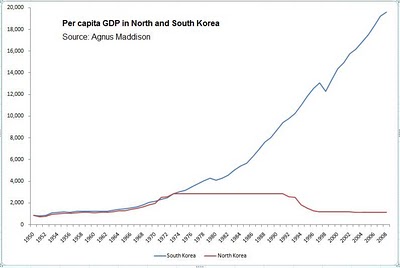北朝鮮経済に関するスウェーデン語の本の書評だが、グラフが興味深い。
Super-Economy: North Korean economic history
韓国と北朝鮮における一人当たりGDPの推移を五十年以上に渡って推計したものだ(データ)。1970前後を境に二つの経済が大きく乖離しているのが分かる。韓国は指数関数的に豊かになっていく一方で、北朝鮮はまったく成長していないどころか九十年代に大きく落ちている。このような共産主義国家における経済の停滞は以下のように説明される。
We can also speculate that centrally planned economies do better the first few decades. When the revolutionary fervor is still high the incentive problems are mitigated. During the initial phase the country can grow through brute capital accumulation (forced savings) and by pushing everyone into the labor force.
共産主義国家の成立直後は革命の余韻もあり労働意欲も高いし、国家権力によって強引に貯蓄・投資を行い、労働人口を拡大させることで経済成長が達成される。
But after a while the socialist economy inevitably runs out of steam, and starts to stagnate. They have never been able to solve the information problem to produce decent consumer goods.
しかし、しばらくするとそういった労働意欲は減衰し、貯蓄・投資の向上や労働人口の増加、教育水準の上昇といった政策にも限界が見えてくる。市場メカニズムなしでは、次に何を生産すべきかを適切に判定することも難しい。
またこのグラフは、経済成長を犠牲にすることの意味も示している。成長率は毎年積み重なっていくものなので、僅かな違いが長期的には莫大な差につながる。仮に1970の時点で北朝鮮国民がたとえ成長が遅れても共産主義でいいと考えていたとしても、四十年後にこれだけの格差を生むことを受け入れたとは思えない。
